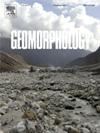Short-term geomorphic response of a mountain stream channel to dam removal and a major flood
IF 3.1
2区 地球科学
Q2 GEOGRAPHY, PHYSICAL
引用次数: 0
Abstract
Despite recent progress, the current understanding of the geomorphic channel responses to river restoration activities, such as dam removal, remains incomplete. Our study addressed this knowledge gap by examining the short-term (first two years) morphological response of a forested mountain channel in the inland Pacific Northwest to a dam removal-generated sediment pulse, which coincided with a considerable flood event. Even though the pulse was equivalent to decades of background sediment transport and the flood had a ≥10-year return interval, our analysis indicated generally limited changes in channel morphology and lateral activity. We attribute this stability to three factors. First, the predominantly fine pulse material was rapidly transferred through the entire length (6.5 km) of the high energy and partly confined channel with limited storage potential. The release of coarse material trapped behind the dam was restricted as part of sediment management. During the 2-year period, the limited coarse component of the pulse induced modest aggradation, extending only 1.5 km downstream of the dam. This highlights trade-offs between hazard management objectives and restoration of sediment-starved channels. Second, erosion during the flood was hindered by coarse and resistant channel boundaries, with banks reinforced by riparian root system and localized rip-rap, and, in the confined reaches, valley margin. Third, low storage of large wood contributed to the subdued morphological response. We observed that logjams, which constricted and deflected the flow, created a hot spot of erosion and deposition where upstream supply of coarse sediment was available. This sediment source was inadvertently generated where in-channel engineering works disrupted bed surface armor and stabilizing bed structures. We propose that the interactions between sediment supply from locally disturbed bed as a conditioning factor, logjam as a forcing element, and flood as a hydraulic trigger could be replicated in river restoration to improve channel complexity and dynamism.
尽管最近取得了一些进展,但目前对河流修复活动(如拆除水坝)引起的河道地貌响应的了解仍不全面。为了填补这一知识空白,我们的研究考察了西北太平洋内陆地区的一条森林山地河道对大坝拆除后产生的沉积物脉冲的短期(头两年)形态响应,该脉冲与相当大的洪水事件同时发生。尽管泥沙脉冲相当于几十年的背景泥沙输运,而且洪水的重现间隔≥10 年,但我们的分析表明,河道形态和横向活动的变化总体上是有限的。我们将这种稳定性归因于三个因素。首先,以细小脉冲物质为主的洪水在高能量和部分封闭、存储潜力有限的河道全长(6.5 千米)内迅速传输。作为泥沙管理的一部分,被困在大坝后的粗颗粒物质的释放受到了限制。在 2 年的时间里,脉冲中有限的粗颗粒物造成了轻微的水位上升,仅延伸至大坝下游 1.5 公里处。这凸显了灾害管理目标与恢复泥沙匮乏的河道之间的权衡。其次,洪水期间的侵蚀受到了粗大而坚固的河道边界的阻碍,河岸受到了河岸根系和局部护坡的加固,在狭窄的河段,河谷边缘也受到了加固。第三,大木头的储量少也是造成形态反应平缓的原因之一。我们观察到,原木坝使水流收缩和偏转,在上游有粗沉积物供应的地方形成了侵蚀和沉积的热点。当河道内的工程破坏了河床表面的装甲和稳定河床的结构时,就会无意中产生这种沉积源。我们建议,在河道恢复过程中,可以复制作为调节因素的局部扰动河床沉积物供应、作为强制因素的原木堵塞以及作为水力触发因素的洪水之间的相互作用,以改善河道的复杂性和动态性。
本文章由计算机程序翻译,如有差异,请以英文原文为准。
求助全文
约1分钟内获得全文
求助全文
来源期刊

Geomorphology
地学-地球科学综合
CiteScore
8.00
自引率
10.30%
发文量
309
审稿时长
3.4 months
期刊介绍:
Our journal''s scope includes geomorphic themes of: tectonics and regional structure; glacial processes and landforms; fluvial sequences, Quaternary environmental change and dating; fluvial processes and landforms; mass movement, slopes and periglacial processes; hillslopes and soil erosion; weathering, karst and soils; aeolian processes and landforms, coastal dunes and arid environments; coastal and marine processes, estuaries and lakes; modelling, theoretical and quantitative geomorphology; DEM, GIS and remote sensing methods and applications; hazards, applied and planetary geomorphology; and volcanics.
 求助内容:
求助内容: 应助结果提醒方式:
应助结果提醒方式:


